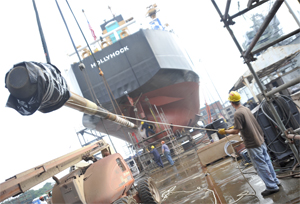At the U.S. Coast Guard Yard in Curtis Bay, Md., workers have the laborious task of performing 12 months of maintenance on each of the service’s legacy 225-foot seagoing buoy tenders at an average cost of roughly $12 million per hull. All 16 Juniper-class cutters (WLB 201-216) are scheduled to be dry-docked for a service life extension to keep them sailing for another 15 years.
While private commercial shipyards fulfill nearly 85 percent of the Coast Guard’s planned depot-level maintenance requirements — including dry-dock availability, dockside maintenance and emergency repairs — Curtis Bay has proven to be an ideal facility for conducting life-cycle repairs and upgrades.
“In particular, the ability to manage configuration control and assess the condition of the entire fleet at an organic Coast Guard facility is invaluable to ensuring continuity in legacy asset sustainment,” Coast Guard officials and program managers told Professional Mariner.
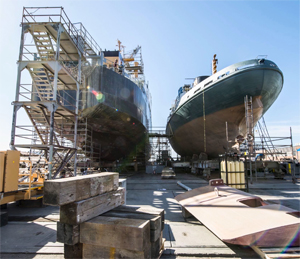 |
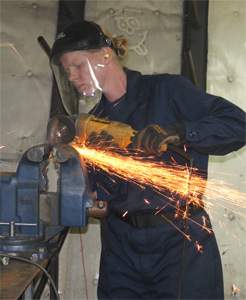 |
|
|
The Juniper-class Willow undergoes maintenance at the yard in 2017 alongside Sturgeon Bay, a 140-foot Bay-class cutter. |
Petty Officer 1st Class Rebecca McMillen-Eickhoff, a damage-control manager aboard Hollyhock, grinds a fitting on the cutter at Curtis Bay in 2013. |
|
|
U.S. Coast Guard photos |
||
Curtis Bay’s history of success with this type of endeavor includes the 225-foot buoy tender service life extension program (SLEP); the 210-foot medium endurance cutter midlife maintenance availability project; the 210-foot and 270-foot medium endurance cutter mission effectiveness project (MEP); the 140-foot icebreaking tugboat SLEP; and the 110-foot patrol boat MEP.
“All of these projects demonstrate the Coast Guard yard’s ability to efficiently plan and execute major ship overhaul projects,” service officials said. “Additionally, Coast Guard Project Resident Office (PRO) Baltimore is located on site (at Curtis Bay) and is able to complete numerous inherently governmental functions.”
Juniper-class vessels are responsible for maintaining short- and long-range aids to navigation (ATON) such as fixed structures and buoys. The multi-mission cutters conduct maritime law enforcement, Homeland Security and Department of Defense operations, and provide search-and-rescue assistance should the need arise. These 225-foot seagoing tenders are not to be confused with the 175-foot coastal buoy tenders (WLM) of the Keeper class.
Ships in the Juniper class were launched and commissioned from 1995 to 2004. The first vessel in the series, Juniper, is 25 years old, while the average age is about 20 years. The cutters are equipped with two Caterpillar 3608 diesel main engines, a single driveshaft, a controllable-pitch propeller, and bow and stern thrusters. A GPS-linked dynamic positioning system (DPS) allows the vessels to approach, maneuver and automatically maintain position when servicing buoys, and a sharply angled bow allows them to conduct icebreaking operations.
Routine work through the midlife maintenance availability (MMA) process is performed at recurring intervals. Examples include eight- to 12-week dry-dockings every four years, or eight-week dockside availability two years after a dry-docking. Routine maintenance is considered operational-level work that can be performed by a ship’s crew, sometimes with support from maintenance augmentation teams.
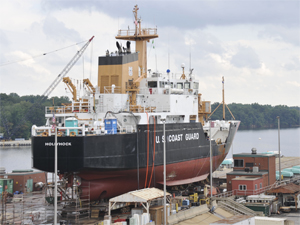 |
|
The buoy tender Hollyhock, built in 2003 by Marinette Marine and home-ported in Port Huron, Mich., is one of 16 Juniper-class cutters scheduled for a 15-year service life extension at Curtis Bay. |
|
U.S. Coast Guard photo |
“A major maintenance program (such as the MMA for the Juniper class) consists of repairs considered depot level beyond the capability of the ship’s force and requiring depot maintenance facilities to conduct,” Coast Guard officials said. “These include dry-docking, major system upgrades, structural repairs and hull painting. SLEP is intended to extend the expected service life of an asset, while MMA is designed to ensure the asset reaches its intended service life.”
Even with the COVID-19 outbreak, the Coast Guard closely monitors progress at Curtis Bay and follows federal guidance and best practices. Juniper-class work involves topside preservation; control, propulsion and alarm systems; buoy crane and deck equipment; HVAC, watermaker and refrigeration systems; renewal and replacement of worn-out steel; new CCTV systems; replacement of boat-launching davits; new buoy deck lighting; stability assessment; and updates to information systems to ensure their reliability and effectiveness against cyberthreats. Buoy ports also are coated with new paint that is more resilient against impacts while conducting ATON operations.
“Some areas that are typically associated with a service life extension project that were not upgraded or modernized during (this MMA) include the galley, berthing areas, mess deck and crew’s lounges,” Coast Guard officials said. Ships in the Juniper class were built after lead and asbestos were known to be hazardous, so the cutters do not require lead or asbestos remediation.
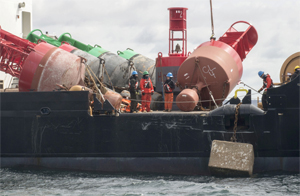 |
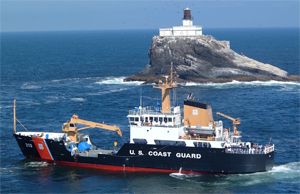 |
|
|
Mariners on the Juniper-class Oak place seasonal buoys in Buzzards Bay in March 2017. |
The cutter Fir passes Tillamook Rock Light on the Oregon coast. Like its Juniper-class sisters, Fir has a dynamic positioning system for safer and more accurate tending of aids to navigation. |
|
|
U.S. Coast Guard photos |
||
Each cutter has a standard work package of repairs. “Age, operating area and material condition may require some cutters to need additional repairs,” Coast Guard officials said. “During the planning process, that standard work package is reviewed and adjusted as necessary to accommodate the needs of the particular cutter. Many of the components being replaced or installed on the buoy tenders are readily available, which is by design as it makes the (WLB) cutters more supportable in the future.”
The Coast Guard is continuously adapting to new technology, including robotics and automation. Cutters in the Juniper class reflect the advancements, with dynamic positioning perhaps the most important improvement. “Using this technology, the crews are able to maintain the vessel’s position within a 10-meter circle in winds of up to 30 knots and waves of up to 8 feet,” service officials said.
As of mid-May, there were no ongoing Coast Guard acquisition initiatives to replace the Juniper-class buoy tenders. Therefore, the service life upgrades should ensure that these 225-foot cutters serve well into the next decade.

